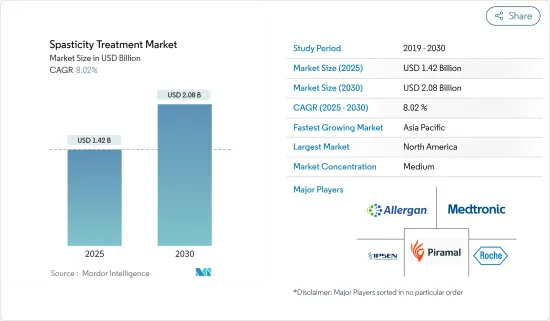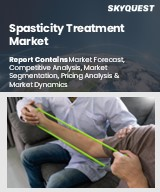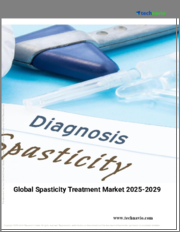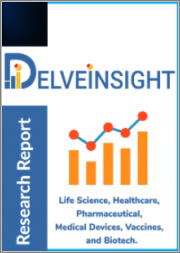
|
시장보고서
상품코드
1689808
세계의 경직 치료 시장 : 점유율 분석, 산업 동향, 성장 예측(2025-2030년)Spasticity Treatment - Market Share Analysis, Industry Trends & Statistics, Growth Forecasts (2025 - 2030) |
||||||
세계의 경직 치료 시장 규모는 2025년 14억 2,000만 달러로 추정되며, 예측 기간 중(2025-2030년) CAGR 8.02%로 확대되어, 2030년에는 20억 8,000만 달러에 달할 것으로 예측됩니다.

시장 성장의 주요 원인은 세계의 다발성 경화증, 뇌성 마비, 뇌염의 유병률 증가, 계발 프로그램 증가, 신기술의 채용입니다.
경직 사례 증가와 경직 치료를 위한 신기술의 채용은 시장의 주요 촉진요인입니다. 예를 들어, Physicians Group LLC가 2023년 12월에 발행한 저널에 따르면 세계 약 1,200만 명이 경직으로 고통받고 있습니다. 이 공급원은 또한 로봇 지원 요법, 전기 자극 요법, 가상현실 요법을 포함한 현대의 물리 요법 접근법은 환자의 운동 기능을 강화하고 경직을 완화하는데 높은 효율을 나타냈다고 말합니다. 또한 2023년 2월 발표된 연구에 따르면 심한 경직을 가진 뇌졸중 환자에게 로봇 지원에 의한 감각운동요법 운동이 적용되어 큰 성과를 보였다고 합니다. 이 연구는 재활 장비에 의한 적극적인 치료가 경직 치료에 다양한 효과를 가져온다고 말합니다.
경직을 치료하기 위한 승인 증가와 특수 제품의 출시는 시장 성장을 가속할 것으로 예상됩니다. Amneal Pharmaceutical은 정제를 삼키기 어려운 경직 환자에게 대체 약물을 제공하기 때문에 빠르게 녹는 맛의 과립제 형태로 이 제품을 개발했습니다.
또한 경직 치료를 위한 첨단 치료 연구 개발이 활발해지고 있는 것도 시장의 성장을 더욱 촉진할 것으로 예상됩니다. 2023년 3월, Saol Therapeutics는 다리 근육 경직에 대한 SL-1002의 임상 개발의 II 단계 결과를 발표했습니다. 또, Sentynl Therapeutics가 임상 개발중인 파이프라인 의약품인 STI-103은 현재 1단계에 있으며, 근 경직에 대한 1단계 의약품은 2단계로 진행하기 위한 PTSR(상전 이전 성공률) 적응 기준은 74%입니다. 따라서 경직 치료의 좋은 결과는 시장에서 경직을 위한 선진적인 치료의 발매가 기대되어 예측 기간 동안 시장 성장을 가속할 것으로 예상됩니다.
그러나, 고액의 치료비가 경직 치료의 보급률을 저하시키는 것이 예상되고, 예측 기간 중 시장 성장의 방해가 될 것으로 예상됩니다.
경직 치료 시장 동향
뇌성 마비 부문이 경직 치료 시장의 주요 점유율을 차지할 전망
뇌성 마비(CP) 부문은 경직 치료 시장에서 가장 큰 점유율을 차지할 것으로 예상됩니다.
뇌성 마비는 세계에서 확인되는 가장 흔한 소아 질환 중 하나입니다. Cerebral Palsy Guidance의 2024년 1월 업데이트에 따르면 미국에서는 약 76만 4,000명(유아와 성인 포함)이 적어도 하나의 뇌성 마비 증상을 또한 매년 약 1만 명의 아기가 뇌성 마비로 태어납니다.
또한, CP와 관련된 임상검사의 실시가 승인된 것도 예측기간 동안 같은 부문의 성장을 더욱 촉진하고 있습니다. 2024년 1월, Neurotech International는 뇌성마비(CP) 치료를 위한 NTI164의 제I/II상 임상검사를 시작하기 위해 인간연구윤리위원회(HREC)로부터 승인을 받고 치료용품국(TGA)으로부터 허가를 받았습니다.
따라서 CP 사례 증가, CP 임상검사 증가, 계몽 프로그램 증가, CP 환자에서 경직 치료의 채용으로 이 부문은 예측 기간 동안 성장할 것으로 예측됩니다.
북미가 예측기간 동안 시장을 독점할 전망
북미는 다발성 경화증(MS) 관련 연구에 대한 자금 제공 증가와 약물전달 솔루션의 개발에 의해 경직 치료 시장을 독점할 것으로 예측됩니다.
경직 증상을 일으키는 질병의 환자 수가 증가하면 국가 시장 성장을 가속할 것으로 예상됩니다. MS Canada의 2024년 2월 최신 정보에 따르면 캐나다는 다발성 경화증(MS)의 이환율이 세계에서 가장 높은 국가 중 하나이며 약 9만 명의 캐나다인이 이 증상을 앓고 있습니다. 평균적으로 매일 12명의 캐나다인이 MS 진단을 받고 있습니다. 대부분의 사람들은 20세에서 49세 사이에 MS로 진단되며, 예측할 수 없는 이 질병의 영향은 평생 지속됩니다.
경직 관리에서 약물의 유익성에 대한 조사가 점점 증가하고 있습니다. 연구는 과학적 근거를 뒷받침하는 경직 치료의 장점을 이해하고 약물 사용을 향상시키는 데 도움이 됩니다. 예를 들어, 텍사스 대학 사우스웨스턴이 2023년 3월에 발표한 연구에서 경장 바클로펜은 뇌성 마비의 경직 치료에 안전하고 효과적인 약물이라고 결론지었습니다. 이 약은 투여가 용이하고 부작용도 적습니다.
다발성 경화증의 이환율 증가와 치료 접근성이 이 나라 시장 성장을 지원하고 있습니다. 게다가 이 나라에서는 비용 효과적인 치료가 가능해지고 있기 때문에 예측 기간 동안 시장 성장이 급증할 것으로 예상됩니다.
경직 치료 산업 개요
경직 치료 시장은 적당한 경쟁이 있으며 여러 선도 기업으로 구성되어 있습니다. 시장 점유율 측면에서 현재 시장을 독점하는 주요 진출기업 중 몇 개가 시장에서 충족되지 않은 과제를 해결하기 위해 신제품을 개발하고 있습니다. 예를 들어, Medtronic은 2023년 10월 만성 통증, 암성 통증, 심한 경직 환자를 위한 차세대 척수강 내 약물 전달 시스템인 SynchroMed III의 미국 식품의약국(FDA) 승인을 받았습니다. 시장을 독점하는 기업으로는 Medtronic PLC, Piramal Enterprises Ltd, Allergan PLC, Ipsen, F. Hoffmann-La Roche Ltd. 등이 있습니다.
기타 혜택
- 엑셀 형식 시장 예측(ME) 시트
- 3개월간의 애널리스트 서포트
목차
제1장 서론
- 조사의 성과
- 조사의 전제
- 조사 범위
제2장 조사 방법
제3장 주요 요약
제4장 시장 역학
- 시장 개요
- 시장 성장 촉진요인
- 계발 프로그램 증가와 신기술의 채용
- 첨단 치료의 출시와 저렴한 가격 증가
- 시장 성장 억제요인
- 치료비의 상승
- 엄격한 규제 틀
- Porter's Five Forces 분석
- 신규 참가업체의 위협
- 구매자/소비자의 협상력
- 공급기업의 협상력
- 대체품의 위협
- 경쟁 기업간 경쟁 관계의 강도
제5장 시장 세분화
- 약제 클래스별
- GABA 작용제
- α2 아드레날린 작용제
- 보툴리눔툭신(보톡스)
- 약제 클래스별
- 적응증
- 다발성 경화증(MS)
- 뇌성 마비(CP)
- 외상성 뇌손상(TBI)
- 기타
- 투여 경로
- 경구
- 비경구
- 최종 사용자
- 소아
- 성인
- 지역
- 북미
- 미국
- 캐나다
- 멕시코
- 유럽
- 독일
- 영국
- 프랑스
- 이탈리아
- 스페인
- 기타 유럽
- 아시아태평양
- 중국
- 일본
- 인도
- 호주
- 한국
- 기타 아시아태평양
- 중동 및 아프리카
- GCC 국가
- 남아프리카
- 기타 중동 및 아프리카
- 남미
- 브라질
- 아르헨티나
- 기타 남미
- 북미
제6장 경쟁 구도
- 기업 프로파일
- Medtronic PLC
- Sun Pharmaceuticals Industries Ltd
- Saol Therapeutics Inc.
- Piramal Enterprises Ltd
- Par Pharmaceuticals LLC
- Allergan PLC
- Ipsen
- F. Hoffmann-La Roche Ltd
- US WorldMeds LLC
- Taj Pharmaceuticals Limited
제7장 시장 기회와 앞으로의 동향
JHS 25.05.07The Spasticity Treatment Market size is estimated at USD 1.42 billion in 2025, and is expected to reach USD 2.08 billion by 2030, at a CAGR of 8.02% during the forecast period (2025-2030).

The major factors attributing to the market's growth are a growing prevalence of multiple sclerosis, cerebral palsy, and encephalitis around the globe, a rise in awareness programs, and the adoption of novel technologies.
The rising cases of spasticity and the adoption of new technologies for spasticity treatment are the key drivers for the market. For instance, according to the journal published by the Physicians Group LLC in December 2023, around 12.0 million people worldwide suffer from spasticity. The same source also stated that contemporary physical therapy approaches, including robotic-assisted therapy, electrical stimulation therapies, and virtual reality therapy, showcased high efficiency in enhancing motor function and reducing spasticity in patients. Also, according to the study published in February 2023, robotic-assisted sensorimotor therapy exercises were applied on stroke subjects with severe spasticity and have showcased significant achievement. The study also stated that active therapy with rehabilitation devices can lead to various benefits in spasticity treatment.
Rising approvals and the launching specialty products to treat spasticity are anticipated to drive market growth. For instance, in June 2022, LYVISPAH, a baclofen oral granules (5, 10, and 20 mg) specialty product approved by the United States FDA for the treatment of spasticity related to multiple sclerosis and other spinal cord disorders, was commercially launched. Amneal Pharmaceutical has developed the product in the form of rapidly dissolving flavored granules to provide an alternative for spasticity patients who have difficulty swallowing pills.
Also, the rising research and development on advanced therapeutics for treating spasticity is anticipated to drive market growth further. For instance, in March 2023, Saol Therapeutics shared its Phase II results of the clinical development of SL-1002 for lower limb muscle spasticity. The phase transition success rate (PTSR) indication standard for Phase II medicines for Lower Limb Muscle Spasticity was found to be 100%. In addition, a pipeline drug, STI-103, is under clinical development by Sentynl Therapeutics and is currently in Phase I. The Phase I drug for muscle spasticity has a 74% phase transition success rate (PTSR) indication benchmark for progressing into Phase II. Therefore, the positive results of spasticity drugs are expected to have the launch of advanced therapeutics for spasticity in the market, thereby anticipated to drive the market growth during the forecast period.
However, the high cost of the treatment is expected to reduce the adoption rate of spasticity treatment, which is expected to hinder the market growth during the forecast period.
Spasticity Treatment Market Trends
The Cerebral Palsy Segment is Expected to Hold the Major Market Share in the Spasticity Treatment Market
The cerebral palsy (CP) segment is expected to account for the largest of the spasticity drugs market. Factors such as an increase in cerebral palsy cases and a rise in benefits offered by spasticity drugs in treating cerebral palsy are expected to drive the segment growth during the forecast period.
Cerebral palsy is one of the most common childhood disorders witnessed around the globe. An increase in cerebral palsy cases and recurring spasticity is expected to drive the demand for the spasticity treatment market, fueling the segment growth during the forecast period. For instance, as per the January 2024 update by Cerebral Palsy Guidance, around 764,000 people in the United States (including children and adults) have at least one symptom of cerebral palsy. Also, around 10,000 babies are born each year with cerebral palsy. Between 1,200 and 1,500 school-aged children are diagnosed with cerebral palsy each year.
Also, the approval to conduct clinical trials related to CP further facilitates the segment growth during the forecast period. For instance, in January 2024, Neurotech International received approval from the Human Research Ethics Committee (HREC) and clearance from the Therapeutic Goods Administration (TGA) to begin a Phase I/II clinical trial of NTI164 for the treatment of cerebral palsy (CP). The study will investigate the efficacy and safety of NTI164 in pediatric patients with spastic CP, the most prevalent form of CP.
Therefore, owing to the increase in CP cases, growing CP clinical trials, rise in awareness programs, and adoption of spasticity therapies among CP patients, the segment is predicted to grow during the forecast period.
North America is Expected to Dominate the Market During the Forecast Period
North America is expected to dominate the spasticity drugs market owing to the increasing funding for multiple sclerosis (MS) related research coupled with the development of drug delivery solutions in the country. Hence, the following factors and market players' initiatives to develop drugs to treat spasticity are projected to support the market growth and maintain a similar trend during the forecast period.
The increasing number of people affected by diseases causing spasticity symptoms is likely to drive market growth in the country. According to MS Canada's February 2024 update, Canada has one of the world's highest rates of multiple sclerosis (MS), with around 90,000 Canadians living with the condition. On average, 12 Canadians receive an MS diagnosis every day. Most people are diagnosed with MS between the ages of 20 and 49, and the effects of the disease, which can be unpredictable, persist throughout their lives.
Research on the benefits of drugs in spasticity management is increasing. The research assists in comprehending the advantages of spasticity drugs supported by scientific evidence and enhancing the usage of the drugs. For instance, a study published in March 2023 by the University of Texas Southwestern in the National Library of Medicine concluded that enteral baclofen is a safe and effective medication for treating spasticity in cerebral palsy. This medication is easy to administer and has minimal side effects.
The growing incidence rates of multiple sclerosis and the accessibility of the treatment have supported the country's growth in the market. Additionally, the increasing availability of cost-effective treatment in the country is anticipated to surge the market growth during the forecast period.
Spasticity Treatment Industry Overview
The spasticity treatment market is moderately competitive and consists of several major players. In terms of market share, a few of the major players currently dominating the market are developing new products to address unmet challenges in the market. For instance, in October 2023, Medtronic received US Food and Drug Administration (FDA) approval for its next-generation SynchroMed III intrathecal drug delivery system for patients with chronic pain, cancer pain, and severe spasticity. Some companies dominating the market are Medtronic PLC, Piramal Enterprises Ltd, Allergan PLC, Ipsen, and F. Hoffmann-La Roche Ltd.
Additional Benefits:
- The market estimate (ME) sheet in Excel format
- 3 months of analyst support
TABLE OF CONTENTS
1 INTRODUCTION
- 1.1 Study Deliverables
- 1.2 Study Assumptions
- 1.3 Scope of the Study
2 RESEARCH METHODOLOGY
3 EXECUTIVE SUMMARY
4 MARKET DYNAMICS
- 4.1 Market Overview
- 4.2 Market Drivers
- 4.2.1 Rise in Awareness Programs and Adoption of Novel Technologies
- 4.2.2 Launch of Advanced Therapeutics and Increased Affordability
- 4.3 Market Restraints
- 4.3.1 High Cost of Treatment
- 4.3.2 Stringent Regulatory Framework
- 4.4 Porter's Five Force Analysis
- 4.4.1 Threat of New Entrants
- 4.4.2 Bargaining Power of Buyers/Consumers
- 4.4.3 Bargaining Power of Suppliers
- 4.4.4 Threat of Substitute Products
- 4.4.5 Intensity of Competitive Rivalry
5 MARKET SEGMENTATION
- 5.1 Drug Class
- 5.1.1 GABA Agonist
- 5.1.2 Alpha2-adrenergic Agonists
- 5.1.3 Botulinum Toxins
- 5.1.4 Other Drug Class
- 5.2 Indication
- 5.2.1 Multiple Sclerosis (MS)
- 5.2.2 Cerebral Palsy (CP)
- 5.2.3 Traumatic Brain Injury (TBI)
- 5.2.4 Other Indications
- 5.3 Route of Administration
- 5.3.1 Oral
- 5.3.2 Parenteral
- 5.4 End User
- 5.4.1 Pediatrics
- 5.4.2 Adults
- 5.5 Geography
- 5.5.1 North America
- 5.5.1.1 United States
- 5.5.1.2 Canada
- 5.5.1.3 Mexico
- 5.5.2 Europe
- 5.5.2.1 Germany
- 5.5.2.2 United Kingdom
- 5.5.2.3 France
- 5.5.2.4 Italy
- 5.5.2.5 Spain
- 5.5.2.6 Rest of Europe
- 5.5.3 Asia-Pacific
- 5.5.3.1 China
- 5.5.3.2 Japan
- 5.5.3.3 India
- 5.5.3.4 Australia
- 5.5.3.5 South Korea
- 5.5.3.6 Rest of Asia-Pacific
- 5.5.4 Middle East and Africa
- 5.5.4.1 GCC
- 5.5.4.2 South Africa
- 5.5.4.3 Rest of Middle East and Africa
- 5.5.5 South America
- 5.5.5.1 Brazil
- 5.5.5.2 Argentina
- 5.5.5.3 Rest of South America
- 5.5.1 North America
6 COMPETITIVE LANDSCAPE
- 6.1 Company Profiles
- 6.1.1 Medtronic PLC
- 6.1.2 Sun Pharmaceuticals Industries Ltd
- 6.1.3 Saol Therapeutics Inc.
- 6.1.4 Piramal Enterprises Ltd
- 6.1.5 Par Pharmaceuticals LLC
- 6.1.6 Allergan PLC
- 6.1.7 Ipsen
- 6.1.8 F. Hoffmann-La Roche Ltd
- 6.1.9 US WorldMeds LLC
- 6.1.10 Taj Pharmaceuticals Limited

















